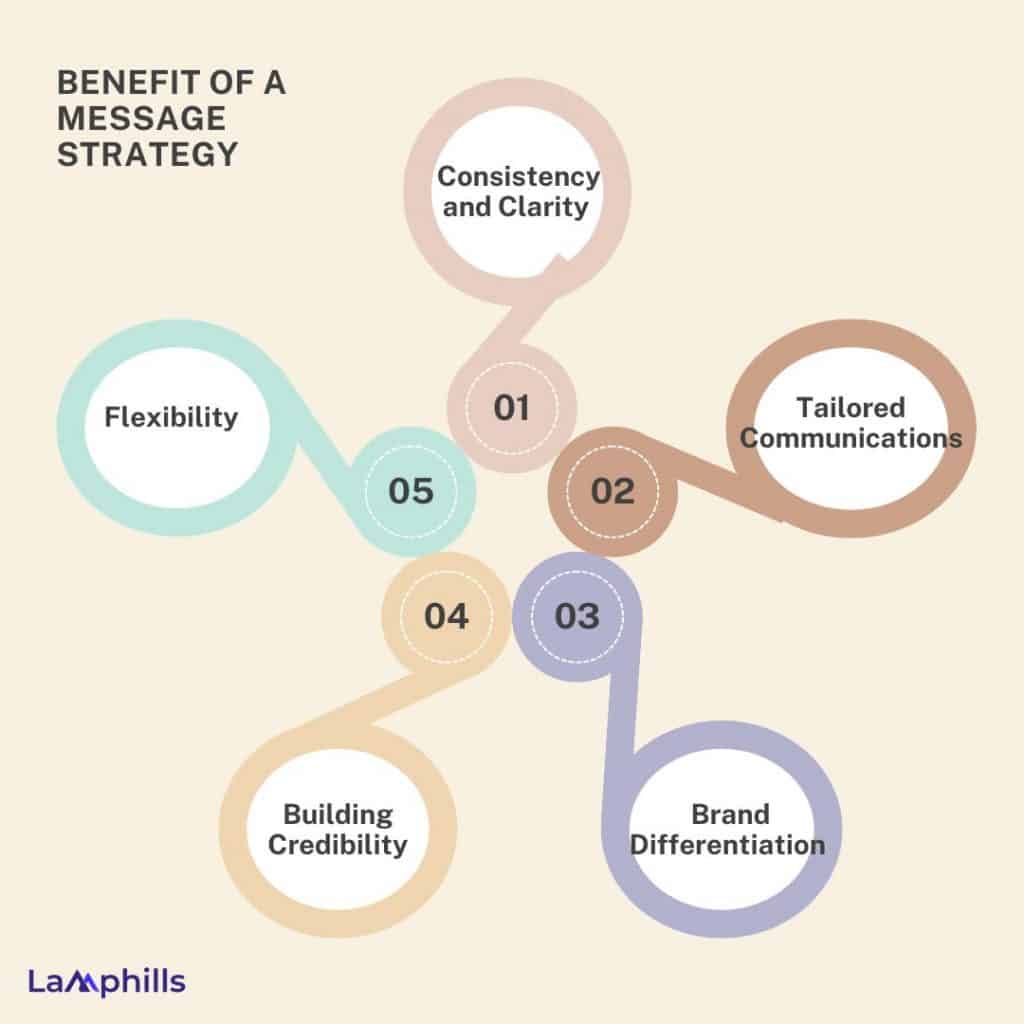A message strategy is the backbone of your brand’s communication. It guides how you convey your brand’s values, vision, and mission to your audience. A well-crafted message strategy ensures consistency, clarity, and impact. In my experience, creating a message strategy requires a deep understanding of your target audience. You need to know what resonates with them and how to connect on an emotional level.
In the next sections, we’ll go into steps on how to create a message strategy that works, explore how to identify your audience, and ensure consistency. Stay tuned to learn how to make your brand’s message strategy truly effective.
Key Points
- A good message strategy makes it easier for your audience to understand and connect with your brand.
- Employing message strategy advertising effectively means understanding your audience and delivering a clear, consistent, and engaging message.
- A compelling story creates an emotional connection, making your audience more likely to remember and act on your message.
- A cohesive messaging strategy ensures consistency and effectiveness in conveying your brand’s value proposition.
- A messaging strategy that can flexibly respond to changing market conditions, customer feedback, or crisis situations demonstrates resilience and foresight.
Understanding Message Strategy
A message strategy is a plan that outlines how you communicate your brand’s message to your audience. It includes what you want to say, who you’re saying it to, and how you’ll deliver the message.
Let’s say, for example, you own a fitness studio. Your message strategy highlights your unique approach to wellness, combining yoga, pilates, and nutrition coaching. You target busy urban professionals, and deliver your message through a blog on your website, sharing success stories, wellness tips, and class schedules. This message strategy positions your studio as a holistic, convenient solution for maintaining a healthy lifestyle amidst a hectic schedule.
Having a strong message strategy helps you stay focused and consistent. It ensures that all your communications reinforce your brand’s identity. A good message strategy makes it easier for your audience to understand and connect with your brand.
Components of a Message Strategy
Creating a message strategy involves more than just words. It’s about connecting with your audience and standing out. Now, Let me break down the components of a message strategy:
#1. Knowing Your Audience
Knowing your audience is very important and different groups need different messages. When you understand who they are, what they like, and what they need, your message hits home. For instance, targeting young professionals requires a different language and platforms compared to reaching retirees. The more you know about your audience’s habits, preferences, and pain points, the better you can tailor your message to resonate deeply with them.
#2. Crafting a Captivating Narrative
A story makes your message memorable, and It’s also about more than facts. From field experience, we know that a well-told story captures attention and stays with the audience. Your message strategy must include a narrative that resonates. A compelling story creates an emotional connection, making your audience more likely to remember and act on your message. It can be a customer testimonial, a brand journey, or even a simple anecdote that aligns with your message.
#3. Highlighting Unique Attributes
What makes you unique? Highlighting these traits sets you apart. In my work, focusing on unique qualities has proven essential. It’s these traits that make your message stand out in a crowded market. Whether it’s an innovative product feature, exceptional customer service, or a unique company mission, these differentiators need to be front and center in your message strategy.
#4. Setting Defined Objectives
Your message should have a purpose. Goals give direction and measure success. From experience, setting clear, achievable goals makes the message strategy effective. Knowing what you aim to achieve keeps the strategy focused. These goals could range from increasing brand awareness to driving sales or growing your social media following. Each goal should be specific, measurable, achievable, relevant, and time-bound (SMART) to ensure your strategy stays on track.
#5. Maintaining Consistency
Consistency builds trust. All parts of your message strategy should align. Inconsistent messages confuse the audience. Field experience shows that a consistent message across all channels strengthens your brand. This means using the same tone, style, and messaging across your website, social media, email campaigns, and any other platform you use. Consistency helps reinforce your brand identity and ensures that your audience receives a coherent and reliable message.
Message Strategy Examples
Crafting a message strategy can make or break a brand’s success. A strong message strategy ensures your audience understands and connects with your brand. Here are real life message strategy examples that illustrate effective communication.
#1. Nike’s “Just Do It” Campaign
Nike’s “Just Do It” is one of the most successful message strategies in history. This message strategy focuses on motivation and empowerment. Nike tells stories of athletes overcoming obstacles, which resonates deeply with a broad audience. The key elements here are simplicity, emotional connection, and consistency. Nike’s message strategy doesn’t just sell shoes; it sells a mindset.
#2. Apple’s “Think Different” Campaign
Apple’s “Think Different” campaign redefined the company. This message strategy celebrated innovation and creativity. By featuring iconic figures like Albert Einstein and Martin Luther King Jr., Apple positioned itself as a brand for the visionary and the forward-thinker. The message strategy emphasized individuality and innovation, helping Apple stand out in a crowded market.
#3. Coca-Cola’s “Share a Coke” Campaign
Coca-Cola’s “Share a Coke” campaign used personalization to connect with customers. By printing popular names on bottles, Coca-Cola encouraged people to find their names and share a Coke with friends. This message strategy was simple yet effective. It created a personal connection with consumers, making them feel special and valued. The result was a boost in sales and brand loyalty.
#4. Dove’s “Real Beauty” Campaign
Dove’s “Real Beauty” campaign challenged conventional beauty standards. This message strategy focused on inclusivity and self-esteem. By showcasing women of various shapes, sizes, and ages, Dove sent a powerful message about real beauty. The message strategy resonated with a wide audience, fostering a positive brand image and increasing engagement. Dove’s approach highlighted authenticity and social responsibility.
#5. Tesla’s Environmental Focus
Tesla’s message strategy centers on sustainability and innovation. By emphasizing the environmental benefits of electric vehicles, Tesla attracts environmentally conscious consumers. The message strategy also showcases Tesla’s cutting-edge technology and vision for the future. This approach positions Tesla as a leader in the automotive industry, appealing to those who value sustainability and innovation.
Creating a message strategy involves several key steps to ensure your message is clear, consistent, and effective. Here’s a checklist to guide you:
Message Strategy Advertising
Message strategy advertising is a plan that outlines the key messages a brand wants to communicate to its target audience. It involves determining the core message, the tone, and the style of communication. Furthermore, It guides what you say and how you say it to make sure your brand connects with your audience. This approach helps maintain consistency, build trust, and effectively convey your brand’s values.
Also, message strategy advertising starts with identifying the core message. This is the main point you want your audience to remember. It should reflect your brand’s values and what makes your product or service unique. Next, you decide on the tone. Should your message be friendly, professional, or playful? The tone should match your brand’s personality and appeal to your audience.
Then, you consider the style of communication. Will you use storytelling, factual information, or humor? The style needs to be engaging and appropriate for your message and audience. In message strategy advertising, consistency is crucial. All your marketing materials—from social media posts to TV ads—should convey the same core message. This builds brand recognition and trust.
See also: How to Develop a Creative Strategy Like a Pro: Tips, Examples, and Templates
A good message strategy advertising plan is adaptable. You need to monitor how your messages are received and be ready to tweak your strategy if needed. This ensures your brand stays relevant and effective in reaching your audience.
Employing message strategy advertising effectively means understanding your audience and delivering a clear, consistent, and engaging message. It’s about creating a connection that drives interest and loyalty to your brand.
What Are the Three Message Strategies?
In marketing, how you deliver your message can be just as important as the message itself. Cognitive, affective, and conative message strategies each offer unique ways to connect with your audience and drive results. Let’s go into each one and explore how they work.
#1. Cognitive Message Strategy
A cognitive message strategy focuses on presenting information and facts to the audience. This strategy appeals to logic and reason, making it ideal for products or services that need detailed explanations or technical data. For example, in the tech industry, I’ve often used cognitive message strategies to highlight features of new software. By laying out clear, detailed information, we helped potential customers understand the product’s value.
#2. Affective Message Strategy
An affective message strategy aims to evoke emotions. This approach connects with the audience on a deeper level by tapping into their feelings, whether it’s joy, fear, love, or nostalgia. When working on a campaign for a non-profit, we used affective message strategies to share personal stories of people the organization helped. These emotional appeals drove higher engagement and donations.
#3. Conative Message Strategy
A conative message strategy is all about driving action. This strategy encourages the audience to do something immediately, like making a purchase or signing up for a service. It often includes clear calls-to-action (CTAs). In retail, I’ve used conative message strategies for holiday sales. By creating urgency with limited-time offers and strong CTAs, we saw a significant increase in sales.
Putting it all together: Understanding and applying these three message strategies—cognitive, affective, and conative can greatly enhance your marketing efforts. By knowing when and how to use each strategy, you can better connect with your audience and achieve your goals.
What Is the Benefit of a Message Strategy?
In the realm of communication strategy, a messaging strategy serves as the backbone, ensuring consistency and clarity in how an organization communicates its key points. It’s more than just crafting words; it’s about strategically aligning your message to resonate with your audience, enhancing credibility, and maintaining adaptability in dynamic environments. Now, let me walk you through these benefits in more detail. first, see the infographic below

#1. Consistency and Clarity
They are foundational benefits of a messaging strategy. Organizations can build a unified brand identity by consistently reinforcing key messages across all channels, from social media to customer service interactions. This uniformity helps stakeholders—be they customers, partners, or employees—understand and remember what the organization stands for, fostering trust and loyalty.
#2. Tailored Communications
This is another critical advantage. A well-crafted messaging strategy allows organizations to customize their messages to specific audience segments. By understanding the unique needs and preferences of different groups, companies can speak directly to their interests, increasing engagement and conversion rates. This targeted approach ensures that each communication effort is meaningful and impactful.
Also see: Marketing Communications: Strategies to Amplify Your Brand’s Voice
#3. Brand Differentiation
The differentiation In a crowded marketplace is often achieved through effective messaging. A strategy that highlights unique selling propositions (USPs) and positions the organization distinctively vis-à-vis competitors can attract attention and drive preference among consumers. It’s about articulating why your offering is superior in a way that resonates deeply with your target audience.
#4. Building Credibility
This is earned through consistent messaging that aligns with organizational values and promises. When messages are clear, truthful, and consistent over time, they build a reputation for reliability and integrity. This credibility not only attracts new customers but also strengthens relationships with existing ones, fostering long-term loyalty and advocacy.
#5. Flexibility
Talking about flexibility is very important in today’s fast-paced world. A messaging strategy that can flexibly respond to changing market conditions, customer feedback, or crisis situations demonstrates resilience and foresight. By staying adaptable, organizations can change course quickly without losing sight of their core values, maintaining relevance and trust even in turbulent times.
How to Build an Effective Messaging Strategy?
Crafting a powerful messaging strategy resembles assembling a puzzle: every element plays a role in forming a unified and compelling whole. Although there isn’t a universal formula, adhering to six essential steps is crucial for ensuring your messaging resonates effectively. Here are the steps:
#1. Understand Your Audience
Start by deeply understanding who your audience is. This involves identifying their needs, preferences, and challenges. By gaining insights into your audience, you can tailor your messaging to resonate with them effectively. Field experience highlights that a targeted approach leads to better engagement and conversion rates.
#2. Monitor Competitor Messaging
Keep a close watch on your competitors’ messaging strategies. Analyze what they’re doing well and where they may be missing the mark. Understanding competitor tactics can help you differentiate your own messaging and capitalize on opportunities in the market.
#3. Gather Customer Insights
Listen attentively to your customers. Utilize feedback, reviews, and interactions to gain valuable insights into their perceptions and behaviors. This firsthand information enables you to refine your messaging strategy to better meet customer expectations and enhance engagement.
#4. Segment Your Audience
Organize your audience into distinct segments based on demographics, behaviors, and interests. Creating an audience matrix allows you to tailor messages specifically to each segment’s preferences and needs. This personalized approach increases the relevance and effectiveness of your messaging efforts.
#5. Organize Data
Compile and analyze all gathered information systematically. By synthesizing data from audience research, competitor analysis, and customer feedback, you can uncover key trends and patterns. This step provides a strategic foundation for crafting cohesive and impactful messaging strategies.
#6. Develop a Cohesive Messaging Strategy
Integrate insights from your audience, competitors, and data analysis to develop a comprehensive messaging strategy. Create clear, concise, and compelling messages that align with your brand voice and resonate with your target audience across various channels. A cohesive messaging strategy ensures consistency and effectiveness in conveying your brand’s value proposition.
Related Article
- Video Storytelling: Its Benefits to Your Brand
- How to Craft an Effective Media Relations Strategy
- Mobile Marketing Strategy Mistakes to Avoid and Best Practices






